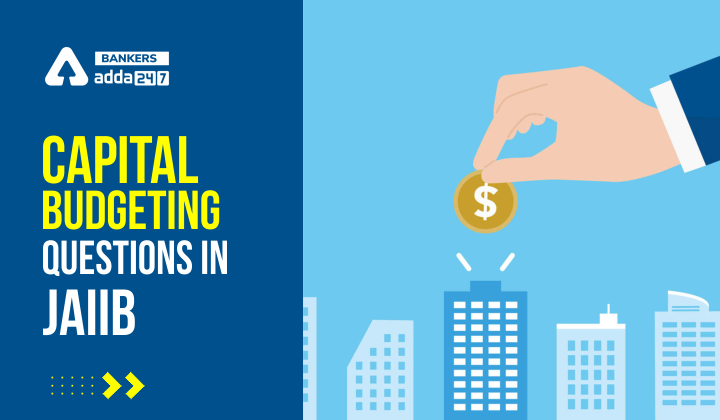Capital Budgeting: Capital Budgeting is a dominant topic in the Accounting and Finance for Bankers(AFB) Paper of JAIIB. One of the predominant functions of management includes Capital Budgeting. Capital Budgeting is one of the tools that are used by organizations to judge their investments and projects. In the process of capital budgeting cash inflows and cash outflows of a project are analyzed and then decide whether the project will yield profit or not. Investment Appraisal is the other name given to the process of Capital Budgeting. The complete details of Capital Budgeting is discussed in the article below.
Capital Budgeting: Definition
The process through which a business decides to purchase any fixed asset or invest in a particular project is called Capital Budgeting. Through the process of capital budgeting the organizations decide to either accept the project or reject it. As a huge amount of money is required in any investment therefore before investing capital budgeting must be done. Capital Budgeting ensures that the investment will be profitable or not and will it be able to achieve the target set by the organization.
Capital Budgeting: Features
There are certain features of Capital Budgeting which are summarized below.
- Capital Budgeting is a long duration fixed investment
- High Risk involving process
- The time period between the starting investment and the expected return is long
- Profit evaluated by the institutions is huge
- All the projects of the organizations require a significant amount of fund
- The future financial status of an organization can be decided by the initial investment done
- The profit acquired through a project is based on the initial investment
Capital Budgeting: Methods
The different methods of Capital Budgeting are:
- Payback Period Method- To counterbalance the initial investment, time taken by a particular project to create a sufficient amount of income is called the Payback Period Method. This method is opted for the investment that is done for a short time duration.
Payback Period= Initial Investment/Annual Cash Flow
- Net Present Value Method(NPV)- The difference between the present price of cash inflow and the present price of cash outflow for a given time duration is called the net present value method. Only the investment that has a positive NPV are taken for consideration. If in an organization there are various projects then the project that has higher NPV will be given priority.
- Accounting Rate of Return(ARR)- In Accounting Rate of Return, the total income generated through an investment is divided by the initial or average investment.
Accounting Rate of Return=Total net income of the investment/Initial or average investment
- Internal Rate of Return(IRR)- The rate at which the NPV becomes zero is called the Internal Rate of Return(IRR). In such a case the rate of cash inflow is equal to the rate of cash outflow. If the IRR is greater than Threshold Rate of Return then the project is selected.
- Profitability Index- Profitability Index is the ratio of the present value of the future cash flows to the initial investment.
Profitability Index= Present Value of the future cash flows/Initial Investment
Factors Affecting Capital Budgeting
The factors that are responsible for affecting the process of Capital Budgeting are listed below.
- Capital Structure
- Capital Return
- Policies of the Government
- Methods of Accounting
- Fund Availability
- Working Capital
- Usefulness of the project
- Decisions of the management
- Taxation Policies
- The lending terms and conditions of financial institutions
- Project’s Economic Value
- Earnings from the project
Capital Budgeting: Objectives
Capital Budgeting is very essential for performing a business. As the effect of capital budgeting is for a long duration so one has to be very precise and follow the following objectives listed here.
- The company/organization will have to choose the most profitable project among the various projects available to them keeping in mind the capital restrictions.
- Keeping the capital cost in control along with the selection of the most profitable investment is the main focus of capital budgeting. The investment must be done on the right project and the capital expenditure should be maintained.
- One of the important prospect of Capital Budgeting is to maintain balance between cost of borrowing and the price of profit estimated. For long term capital investment one has to select the appropriate source of fund.
Related Posts:
FAQs: Capital Budgeting
Q.1 What do you mean by Capital Budgeting?
Ans. The process through which a business decides to purchase any fixed asset or invest in a particular project is called Capital Budgeting.
Q.2 What are the different methods of Capital Budgeting?
Ans. The different methods of Capital Budgeting are Payback Period Method, Net Present Value Method(NPV), Accounting Rate of Return(ARR), Internal Rate of Return(IRR), and Profitability Index.
Q.3 What are the Objectives of Capital Budgeting?
Ans. The main objectives of capital budgeting are to select the profitable project, control the capital expenditure, and choose the most appropriate source of fund.
Q.4 What are the factors affecting Capital Budgeting?
Ans. The factors affecting Capital Budgeting are Capital Structure, Capital Return, Policies of the Government, Working Capital, Methods of Accounting, etc.






 GA Capsule for SBI Clerk Mains 2025, Dow...
GA Capsule for SBI Clerk Mains 2025, Dow...
 The Hindu Review October 2022: Download ...
The Hindu Review October 2022: Download ...
 SBI PO Cut Off 2025, Check Category Wise...
SBI PO Cut Off 2025, Check Category Wise...





